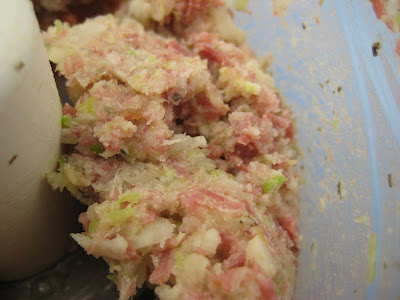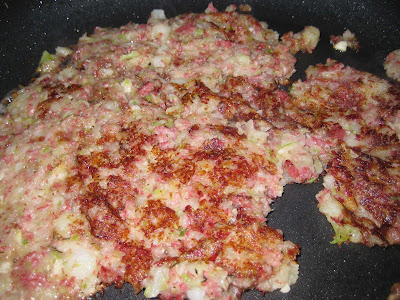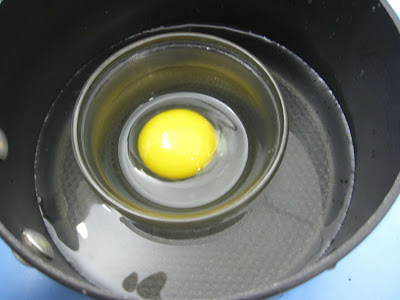Actually, since my first attempt at corned beef hash, I've been craving poached eggs.
I'm craving a fluffy, tender, silky smooth poached egg. Corned beef has is just a means to the end.
Corned beef hash... The last time the dish was a little dry so this time I added boiled cabbage and raw onions to add moisture to the mixture.
The Fixins
1/2 C Corned Beef, diced. (That's all I had)
1/2 C Cabbage, boiled and drained
1/2 C Potatoes, Frozen Southern Style Hash Browns (Didn't have fresh)
1/4 Small Onions, coarse chop
1 Clove Garlic
Tarragon
Thyme
Place ingredients in a food processor.
Corned beef, onions, garlic, thyme and tarragon.

Added potatoes and cabbage

This time I ran the food processor to really mix and grind the ingredients together as shown below.

Pan fry in a little butter

Now to the main point of my craving - poaching eggs.
As a gift, I received Julia Child's cookbook, The Way to Cook.
Her method for poaching eggs calls for piercing the egg at the "fat" end where the air sac is located. Next, the egg is submerged in boiling water for 10 seconds. This is supposed to help coagulate a thin film of egg white around the shell which helps keep eggs together when added to the poaching water.
Egg with the small hole at the air sac end.
Note: When I dropped the egg into the boiling water, egg white was shooting out of the hole so I panicked and plucked the egg out after 5 or 6 seconds.

A pot of water is brought to about a simmer where bubbles are barely forming.
2.5 T of vinegar was added to 1 quart of water. The water tasted like a very weak lemon. The acid helps the egg proteins to coagulate instead of spreading out.
The egg poaching away. When I cracked the egg into the water, it sank to the bottom and a small bit stuck to the bottom. I waited a few seconds and used a spatula to gently release the egg. The egg was poached about 4 minutes.

This is my control egg. Just an egg cracked into a custard cup and gently slipped into the water. Interestingly, the egg did spread out more. The vinegar appeared to help keep the egg from really spreading out into thin wisp. Also, note the water is fairly clean. Usually without vinegar there would be stray bits of egg white floating in the poaching liquid. This egg also sank to the bottom of the pan. I used the spatula to release the egg.

The Final Dish
Corned beef hash over toasted English muffin topped with the poached eggs.
The egg on the left is the control egg while the egg on the right is the 10 second boiled egg.

Overall, the corned beef has was a lot better this time around. The extra moisture helped. Surprisingly, Julia Child's 10 second boil method produced a nice looking egg that was very tender (melt in your mouth, sort of) and light. The control egg was fine, but not as fluffy and tender.
BONUS METHOD:
I remember working in a small diner where a customers would occasionally request poached eggs. The eggs were cooked in little metal cups. Since I didn't have any poaching cups, I used a buttered custard cup to cook the egg.
I brought the water to boil with the cup in place. I was worried the cup would crack if I placed the cup into boiling water.

The egg was boiled for about 5 or 6 minutes, covered. When I lifted the lid, I caught a slight whiff of hydrogen sulfide... One reason I really don't like hard boiled eggs.

The egg plated. Retains it's shape. Looks like a flying saucer.

The egg is cooked medium. It's pretty much a hard-boiled egg. Egg whites kind of dense. Not fluffy and tender. Note to self... don't use egg cups when poaching eggs. Julia Child's method and vinegared water is the way to go.


No comments:
Post a Comment